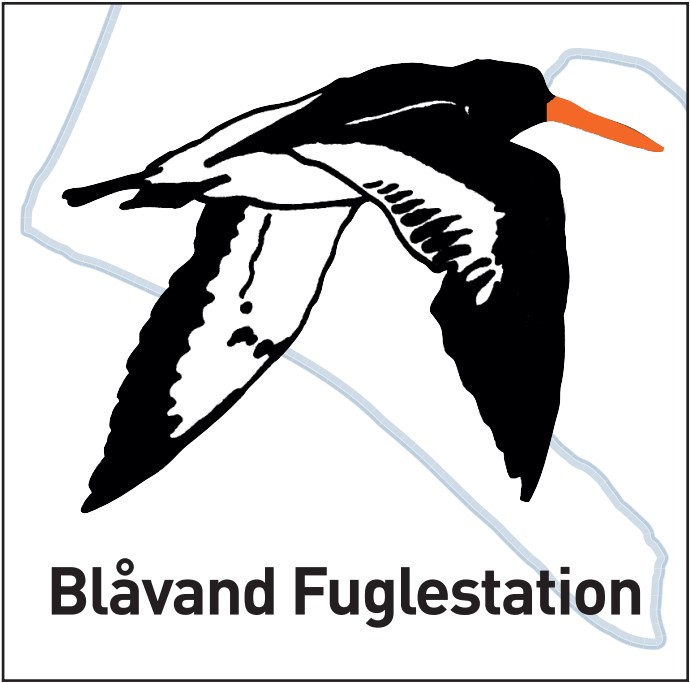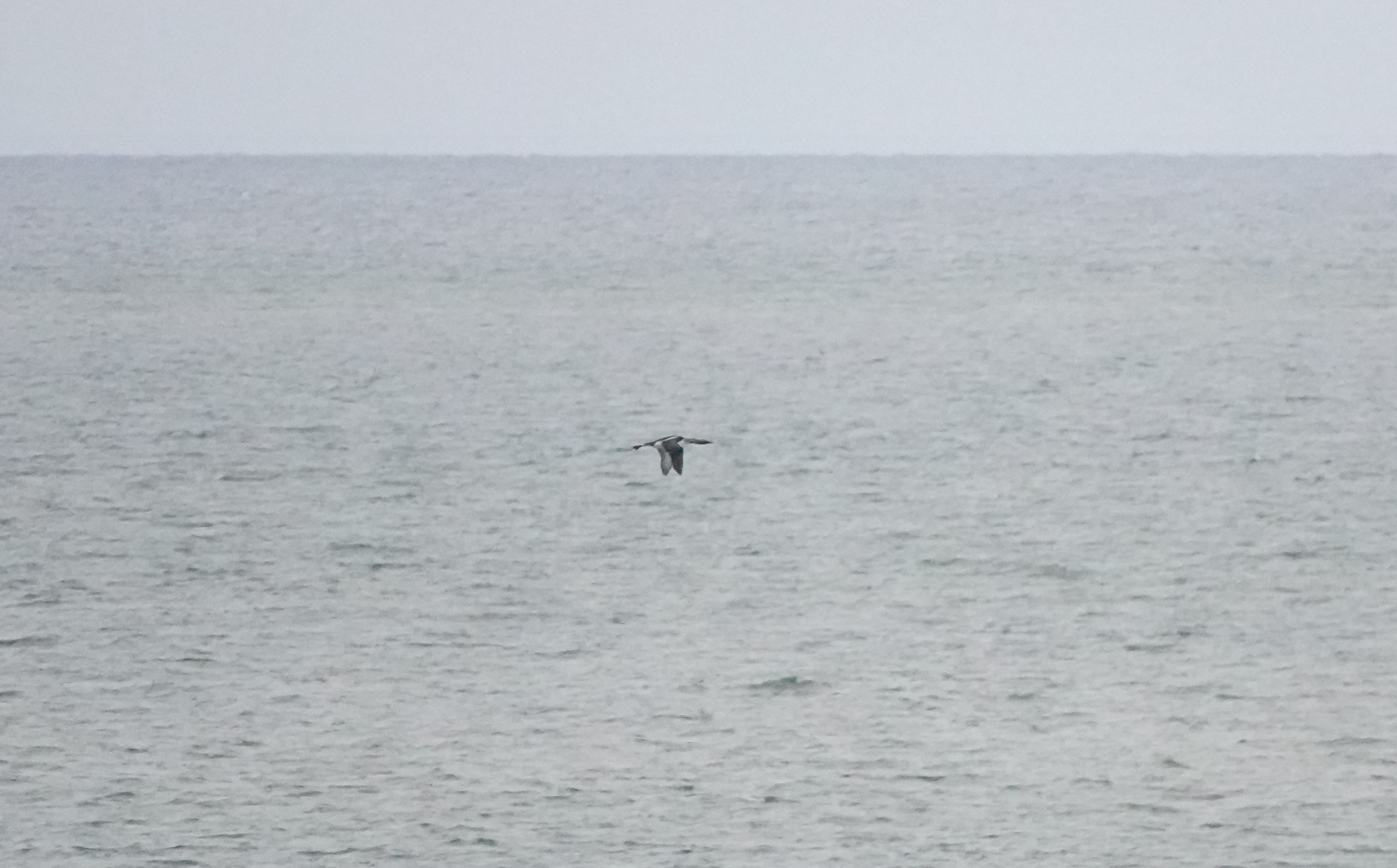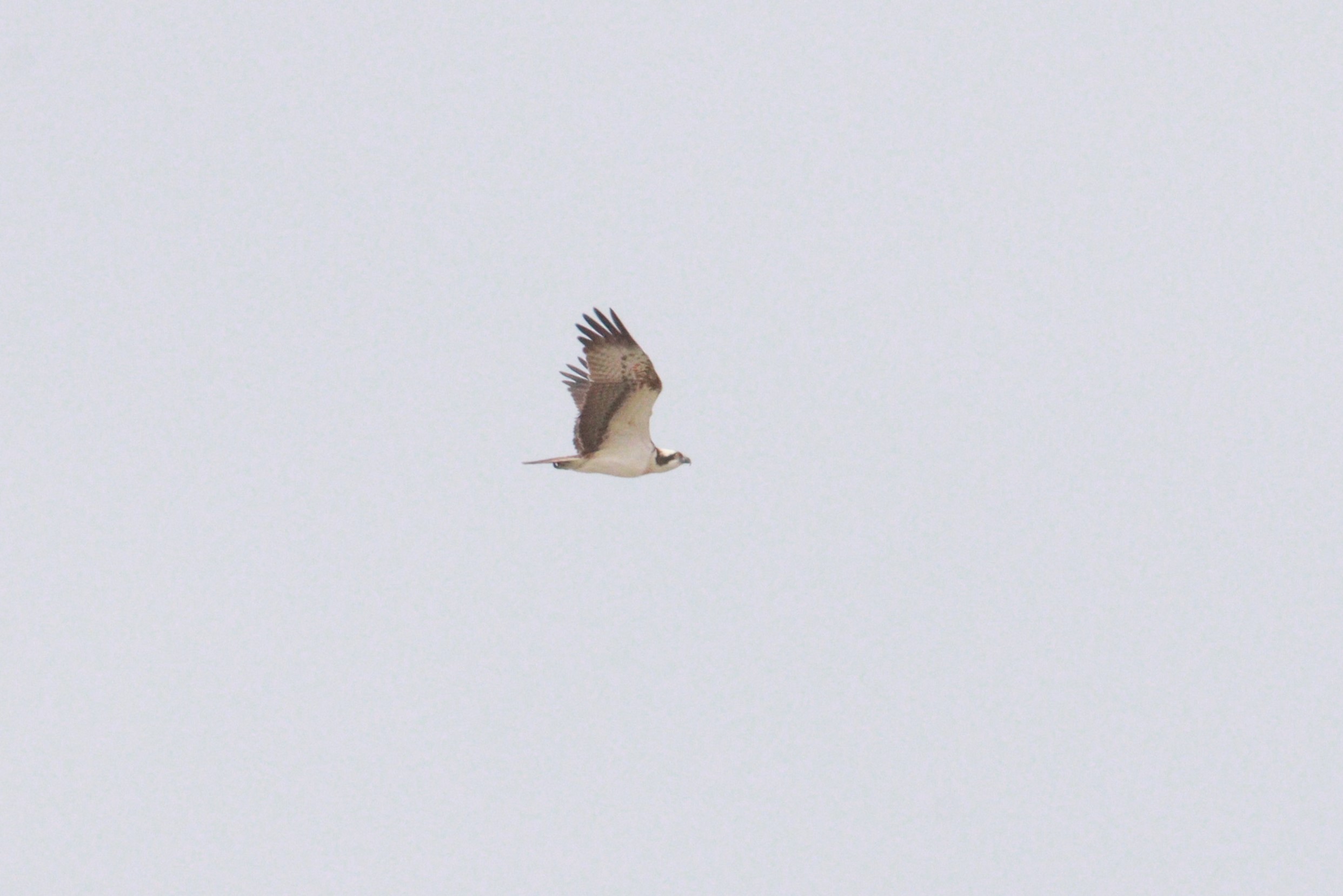Her på Blåvand's blog bringes korte nyheder i dagbogsformat om livet og hændelser på fuglestationen.
Se indlæg fra måned: feb. (4)mar. (31)apr. (30)maj (30)juni (15)juli (19)aug. (21)sept. (30)okt. (31)nov. (30)dec. (2)
I morgen... I morgen bliver det godt!
Så drejede vinden i SV og det plejer jo at være godt. I hvert fald for trækket. Det kunne bare ikke helt mærkes i dag. Selv om det var underholdende med over 1000 h/f-terner, sortstrubet lom og 4 sortterner, kan det ikke helt mærkes at fuglene bør strømme igennem. Der var lidt flere lommer i dag (over 200) og det kan være at det bygger op til i morgen, hvor vinden går i NV. Det er ikke en helt skidt vindretning til store lom-dage. Det leder frem til bloggens titel "i morgen bliver det godt", som er noget vi siger en del for tiden, hvor vi ser frem til at der også falder lidt rariteter eller gode tal af til Blåvand.
Det blev ikke til meget lusk i området, da jeg også tæller ynglefugle for tiden, primært på Skallingen. Det gjorde at jeg ud på eftermiddagen missede en hærfugl, som Michael fandt nede i mosen. Dem er der ikke mange af på disse kanter.
Ringmærkningen gik også sløvt og det sidste jeg hørte, var at Michael og Maxim havde fanget 13 fugle, og kun 5 af dem var nye fugle. Ikke helt den store drøm for en ringmærker. Michael har dog modtaget farveringende til de rødryggede tornskader, så vi sætter nok snart gang i at få dem indfanget og mærket. Vi har fået specialtilladelse til at indfange alle tornskader i det militære område, syd for no-go-zonen, hvor der sidste år befandt sig 6 ynglepar.
Folk på stationen: Maxim, Michael, Henrik.
Calm days with a fast pace
Ringing together with Michael has been a nice change of pace after two months of ringing. And I don’t mean that just figuratively. The young man has a fast pace walking the rounds and every time a bird the size of a Starling or bigger ends up in the nets he runs straight for the bird, not giving them a chance to escape! It is quite a different energy compared to the calm way the days go ringing with Morten.
More Chiffchaffs ended up in the nets compared to the Willow Warblers today, which hasn’t happened in a while. Asking Henrik about it, he mentioned that Chiffchaffs might like the colder weather better (it’s a bit colder today) or more likely they have had some pretty bad days lately and have just given up on breeding this year and are already going back south. But don’t worry Chiffchaffs, as they say, tomorrow will be a better day and if not just wait until the day after tomorrow, that will truly be a good day!
Henrik did the morning observations today and as usual the numbers were not big, but Henrik did spot six Caspian Gulls and a Caspian Tern on the beach!

Caspian Tern
After standard time I went back to work behind the desk while Michael walked the rounds by himself until 1 O’clock catching a view more birds. After closing the nets Micheal went to the dunes to see if he could lure birds with some big fat mealworms into a clap trap. He ended up catching a Stonechat!
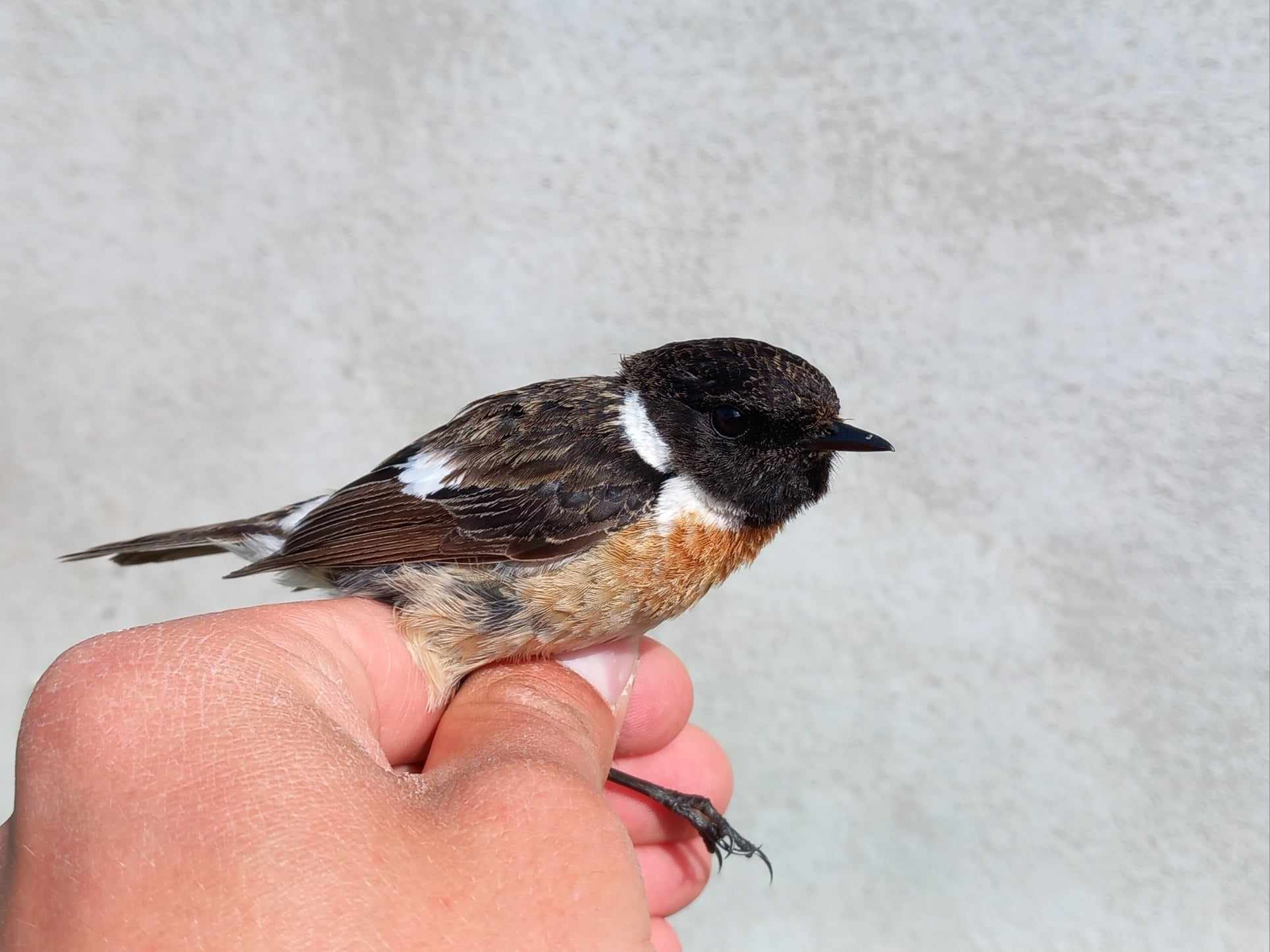
Stonechat
Today 23 birds were ringed and 8 recaptured. The day consisted mostly of the more frequent birds of late such as Chiffchaffs, Lesser Whitethroats, Redstarts and Willow Warblers (the Blackcaps were notably absent today). A Garden - and Icterine Warbler were ringed and to top it off my favourites: two Blue Tits and two Wrynecks were ringed as well.
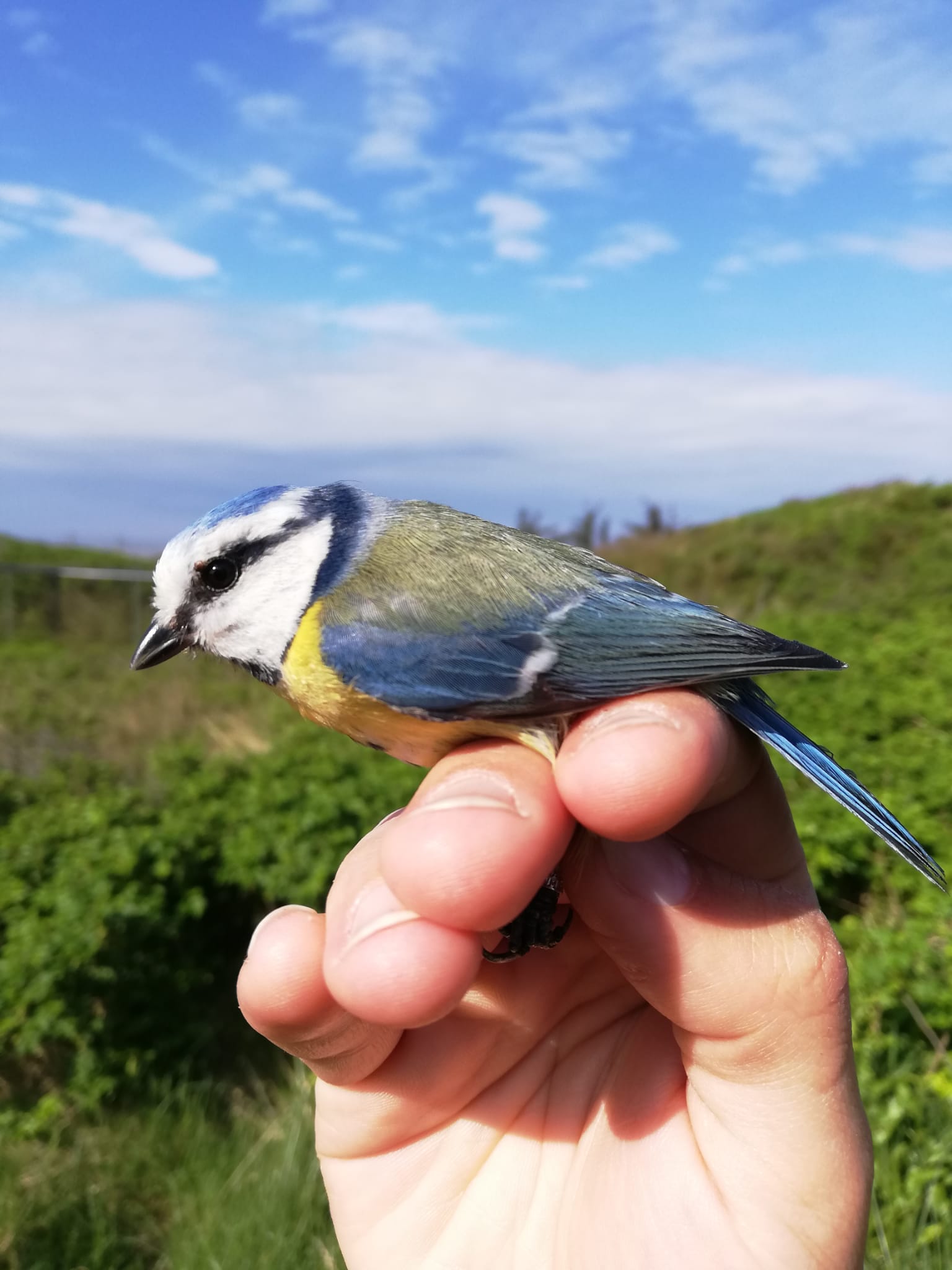
Blue Tit

Wryneck
an amelanistic appearance
Today was the first day that Maxim and I could ring together without anyone else present, because yesterday I upgraded to a C-license, wich means I can ring without supervision, only with an experienced ringer in a range of 20 minutes. That person was Henrik, who did the morning observations. First he was looking at the migration, after that he searched the whole southern coast for birds. He saw among others a black tern, more than 1000 common or artic terns and a grey wagtail.
The ringing was slow. There weren't a lot of birds, but it wasn't to bad either. On one point, I said to Maxim after doing a short round through the lighthouse garden, let's grab something to eat, I am hungry! But when I arrived, I suddenly saw in one of the back net a big, grey bird. Wood pigeon! I sprinted towards it and was able to catch and ring it. Wile ringing the pigeon, Maxim was able to catch a starling and one of the wrynecks hanging around, great, but I was still hungry.
It slowed down fast and while Maxim worked on the computer, I continued the ringing. Just after Maxim left to do his work, I caugth my first crested tit, wich I was hoping for for the past week. On one point, I wanted to take out a willow warbler, when I suddenly heard something bigger was flapping its wings, I immediatly turned around and sprinted to the net, sparrowhawk! But before I was able to grab it, it was gone...

In between the rounds I walked around hoping to find something exciting. In the dunes I saw a sand lizard in front of me, but it wasn't the normal colour. I picked it up to check if it was really an alive sand lizard, and it was. This colour deviation is called amelanism, very cool to see!

At the end we caught 43 birds, 31 new and 12 controls.
Medlemmernes dag
Vinden var gået i N-NØ og der lå et truende regnvejr syd for Blåvand og bevægede sig langsomt men sikkert op imod os.
Böhmer kom ud tidligt på morgenen, for at tage morgenobsen sammen med mig. Morgenobsen var en meget stille omgang. Som de andre dage starter dagen med morgentrækket af terner, hvor der kommer nogle hundrede i løbet af den første times tid. Efter det dør det ud og så afhænger obsen var sortænder, suler og rødlommer, og ingen af disse arter kom i store antal i dag. Mest bemærkelsesværdige for morgenen var en nordtrækkende skestork som er en fåtallig men nok lige præcis årlig gæst på hukket:
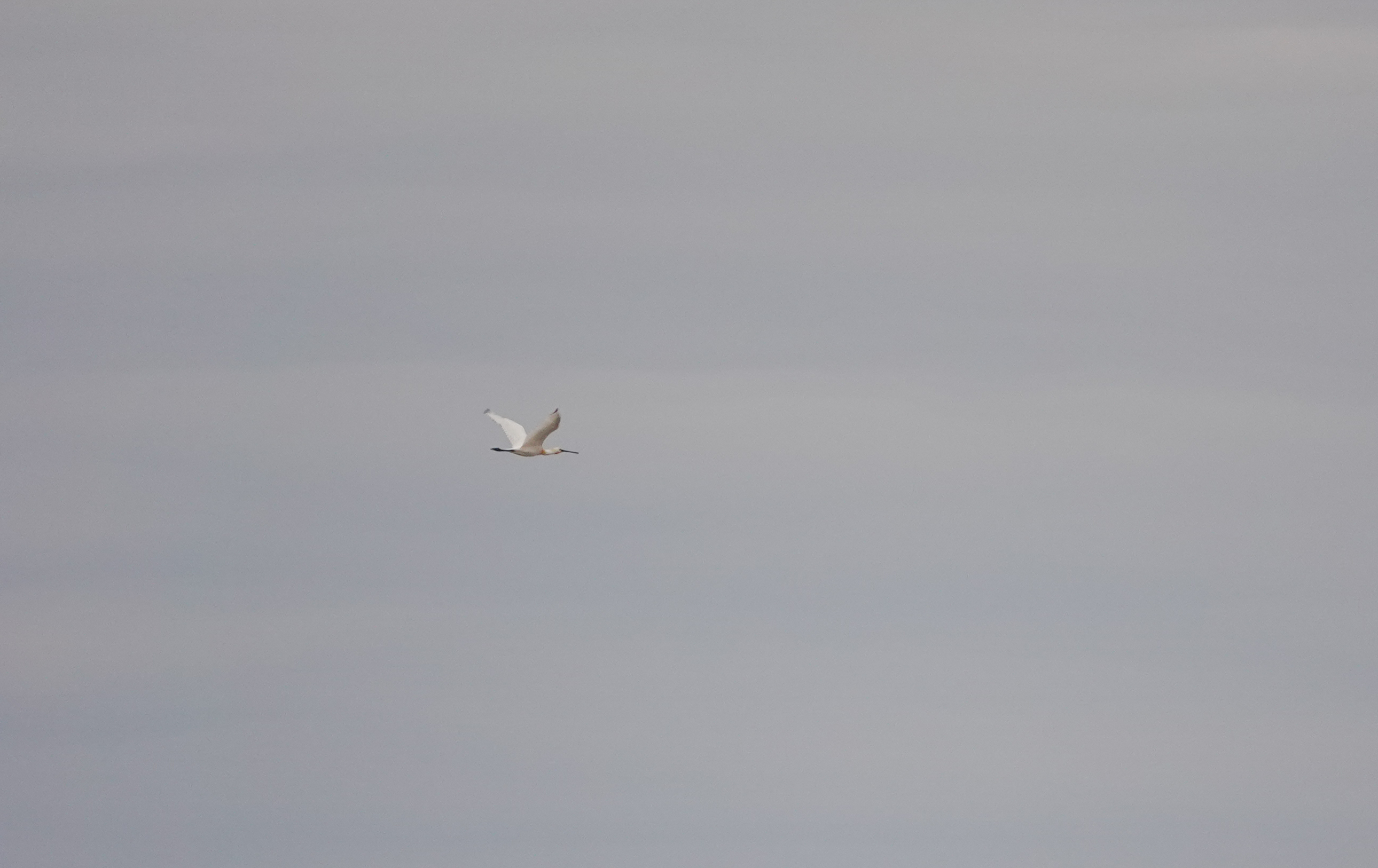 SSkestork nordtrækkende. Foto Henrik Böhmer
SSkestork nordtrækkende. Foto Henrik Böhmer
Mærkerne havde en anelse mere at se til end os i trækobservatører. De havde dog fornøjelsen af at fange 18 Løvsangere som blev dagens mest talrige fugl i nettet. Hernæst kom Rødstjert med 7 fugle. Dagstotalen for ringmærkede fugle kom op på 40 fugle mærket.
Udover de daglige pligter omkring stationen var der medlemmernes dag hvor 27 deltagere mødte op, for at se ringmærkning, høre lidt om Blåvand samt komme på stranden og se til fuglelivet på stranden og ikke mindst hvordan det går med dværgternerne i indhegningen.
Naturbutikken var desuden også til stede med kikkerter, bøger og teleskoper.
Dette skete naturligvis i kombination med servering af rundstykker og frokost i form af pølser og brød.
//DMa
Havesangere og årets første unge
Jeg er taget på et weekendophold på fuglestationen og i dag har været en ganske fin dag på Blåvand Fuglestation med masser af højdepunkter. Jeg stod for nettene i Fyrhaven og Fyrkrattet med Maxim, imens Morten stod for nettene i Stationshaven med Michael. Havesangerne er dukket op i dag og her til morgen havde vi tre fugle, som nu alle er udstyret med nye ringe. Årets anden Tornsanger er også kommet efter årets første kom noget tidligt for et par uger siden. Morten genaflæste en Jernspurv med en ring fra Helgoland, hvilket er årets anden fangst af en fugl med tysk ring.

Jernspurv med ring fra Helgoland
Hen ad formiddagen, da vi tjekkede Fyrkrattet, så vi en stor fugl baske rundt i det ene net og Michael løb hen og fik fat i den, inden den smuttede ud af nettet. Det var en Ringdue og sæsonens sjette, hvilket efterhånden er et højt tal af fangede Ringduer. Det er også første gang jeg ser en i hånden og selvom den ses overalt i haver og skove, var jeg meget begejstret for at se den tæt på og kunne beundre dens smukke træk og intense øjne. Hen ad eftermiddagen prøvede vi at åbne net igen, hvilket gav en genfangst i Stationshaven af Vendehals. Dette er forventeligt, da de yngler i en af havens kasser og synet af dem kan nydes, når de enten fouragerer eller synger i haven. Ellers gav eftermiddagsfangsten ikke så meget, udover en overraskende tidlig unge af Sangdrossel, som var hoppet ind i bunden af nettet. Den har kun lige forladt reden og skulle endnu lære at flyve, men kunne hoppe rundt på jorden og kalde på de voksne fugle.

Sangdrossel unge
Så alt i alt har det været en god lørdag på Blåvand Fuglestation. Søndag bliver en sjov vindretning men med lidt regn i sigte og 30+ besøgende, så det skal nok også blive en spændende dag!

Red-backed Shrike arrived
Just like yesterday it was windy again. Luckely not as much wind as yesterday, but it was still strong. While Morten and Maxim where opening the nets, I went out for the morning observations again. And just like yesterday, the numbers were not great, although I had some nice species such as black guillemot (personally my first one ever), 2 arctic skuas and a crane far away above the see.
While I was counting, Maxim and Morten where ringing, this time the nets in the lighthouse garden could be opened, except a few because of the wind. When I got back, Maxim and Morten where just going to do their round, and after that, we went to sit in front of the station. Suddenly, Morten called in a Hobby, awesome, the first one of the year!
After another round of ringing I went out again, hoping to find the first red-backed shrike of the season. First, I found a stonechat nest, then a corn bunting close to the lake and after 1,5 hours, I finally saw the red back I was hoping to see. Yes!

On my way back, I also saw a winchat sitting pretty close to me. I don't see them often, so that was a nice find too.
When I got back at the station, Morten was still hoping to catch the serin we found yesterday above the nets. while we were sitting in the garden, we suddenly saw a grey bird going for the pond. It appeared to be a second spotted flycatcher after the one we ringed a few days ago!
Ringing:
people at the station: Maxim, Morten and Michael
Energetic Winds
With another day of strong easterly winds and a bright and sunny day, it seemed that all of Blåvand was in an energetic dance: The branches and leaves on the trees, the slim black treads of the mist nets, hats that blew off the head of tourist showing their sunburned faces and of course, the birds flying through the sky.
The strong wind meant that very view nets could be opened today. The wind turned out to be so strong that after the first round we closed all the nets at the lighthouse garden. Leaving only five nets open in the station garden.
The day did start out promising when during the first round two Redstarts were already in the nets. In total 17 birds were ringed today which is not bad all things considered. There were the usual visitors of Blackcaps and Lesser Whitethroats, but the most notable species of the day was a Brambling, we haven’t had that many of this species this season. Later in the day Morten opened the nets again when he heard a Serin call in the station garden. As of writing this blog the nets have been open again for several hours with no luck of catching the Serin, but Morten has not given up yet, so maybe there will be a joyous update tomorrow!
With none of the household names being able to do the morning observations Michael stepped up to the plate. Although no great number of migrating birds, Michael did spot a Black tern this morning! After morning observations Michael took another crack at reading the rings of birds around the station. Today he managed to read four rings! One from a White Wagtail and of three Tree Sparrows. One of the Tree Sparrows has not been controlled since 2022. This bird has been sneaking around the station for two years without anyone here knowing it was still around, not until Michael showed up with his unrelenting effort. And when you think this young man is busy enough looking at birds, he also managed to spot a beautiful Emperor moth.

Emperor Moth
People at the station: Michael, Morten and Maxim
Travl dag med sommertemperatur og østenvind
Med østenvind, klar himmel og temperatur der steg fra 11 grader ved solopgang til +20 grader over middag var der nærmest dømt sommerstemning herude mod vest.
Det gav en ganske fin ringmærkningsdag med 55 fugle ringmærket og 7 genfanget plus en aflæst Hvid Vipstjert, som ihærdige Michael fik hele ringnummeret på ved at følge den i teleskopet på gårdspladsen.
Den var mærket her i 2022, mens hans aflæste Sølvmåge fra i går er hele 12 år gammel og dengang blev mærket på Langli.
Ihærdig er den unge mand altså - efter vi andres sengetid i går aftes var han en tur på stranden og klitkanten ved Nordhukket, hvor han fik set en Mosehornugle.
Alt for sent til at komme med på blogegn fra i går, men den art er da værd at nævne her.
Største overraskelse i nettene idag blev en tidlig Grå Fluesnapper.
Ved søgning på DOFbasen er det tidligste fund af arten for Blåvand Fuglestation, da de tidligste ankomster her hidtil er registreret til 02. maj.

Midt på formiddagen og et par timer frem havde vi besøg fra DR TV, hvor makkerparret bag udsendelsen ”Jorden kalder” fulgte os på netrunderne og også fik en snak med Henrik om brug af ringmærkningsdata.
Vi må vente med at se resultatet af de optagelser til programmet bliver sendt på et tidspunkt i løbet af sommeren.
Inden TV holdet dukkede op havde Henrik taget sig af morgenobsen fra Sydhukket.
Mest nævneværdigt fra stranden var, at der blev talt 32 rastende Dværgterner.
Det bygger da op til, at vi får en del ynglepar at holde øje med i det indhegnede område på Nordhukket.
Lige inden DR forlod os hørte Henrik en Skovsanger fra den bagerste del af Stationshaven.
Desværre ville den ikke besøge vores net i de timer den holdt til i området, så den kom ikke på ringmærkningslisten i dag, men vi håber på arten igen i morgen – det er en lækker phyll at stå med og knap årligt i nettene her om foråret.
Østenvinden gav igen lidt rovfugle i luften herude med både Rød Glente, flere trækkende Rørhøge og 2 overflyvende Havørne.
Nu mangler vi lidt ædlefalke for at havde rigtig gavn af den vedvarende østenvind og fx Lærkefalk må være en target art i morgen.
Dagens ringmærkning:
Folk på stationen: Henrik, Michael, Maxim og Morten
A calm but exciting day
My first full day on the birdstation, what would it bring? Let’s start with an introduction, I am Michael, 19 years old and I come from the Netherlands. I am a intern at the Blåvand fuglestation and I will be busy with ringing and reading rings, counting and my own project with red-backed shrikes, of which more later.
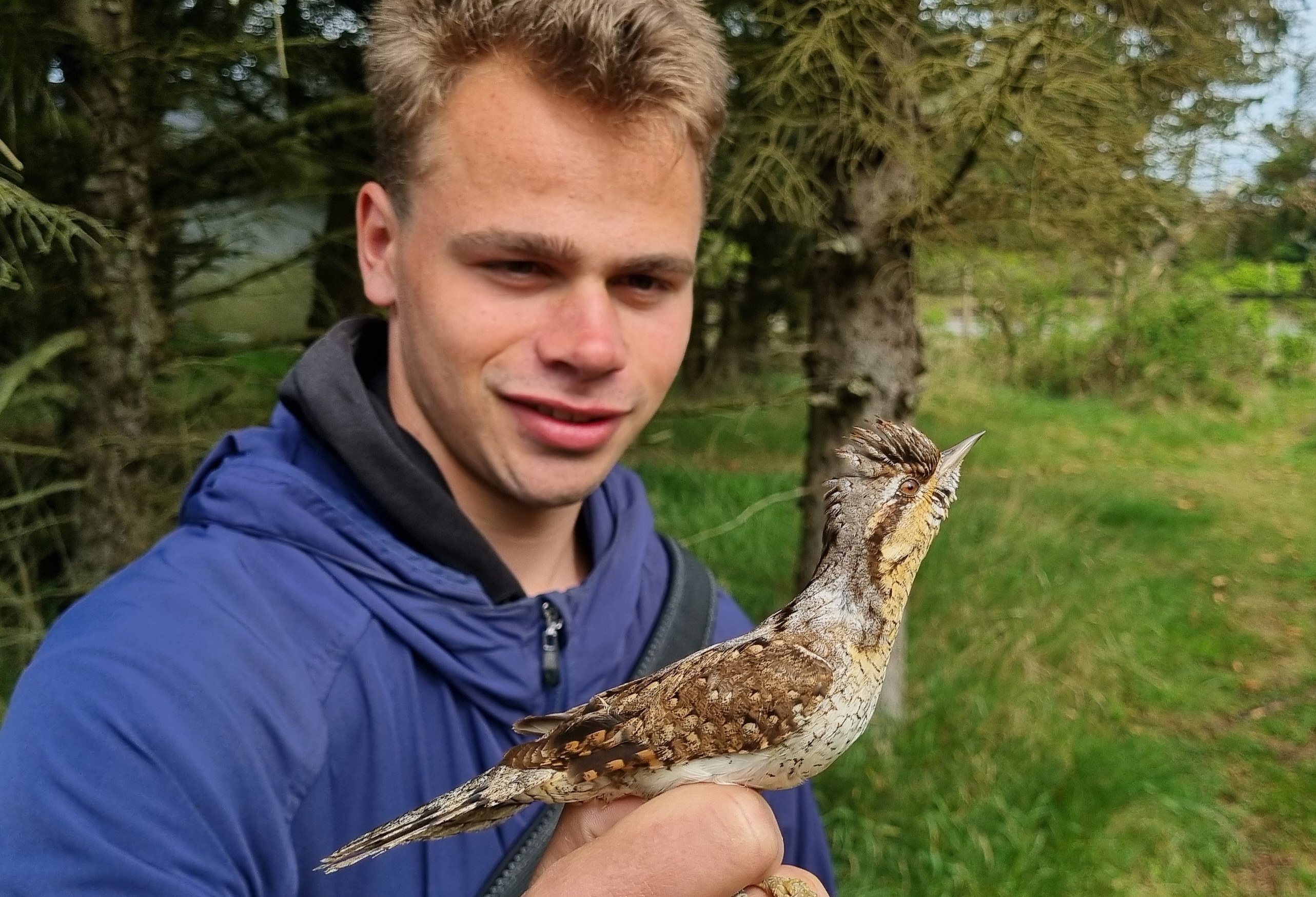
Today the day started slow, there was almost no arrival and we had 8 birds after 1,5 hours. We had one striking willow warbler, it was greyer than usual, which might indicate it was a northern willow warbler. After the 1,5 hours of ringing, we had to close the nets because of the rain, not promising. After a few hours the rain stopped, and we opened the nets in the garden again. The first round was nothing, so we went to Henrik who was already counting again, but due to the low numbers of birds, we went back again. From the parking area I at least saw one bird in the net, nice. This appeared to be a wryneck, awesome!
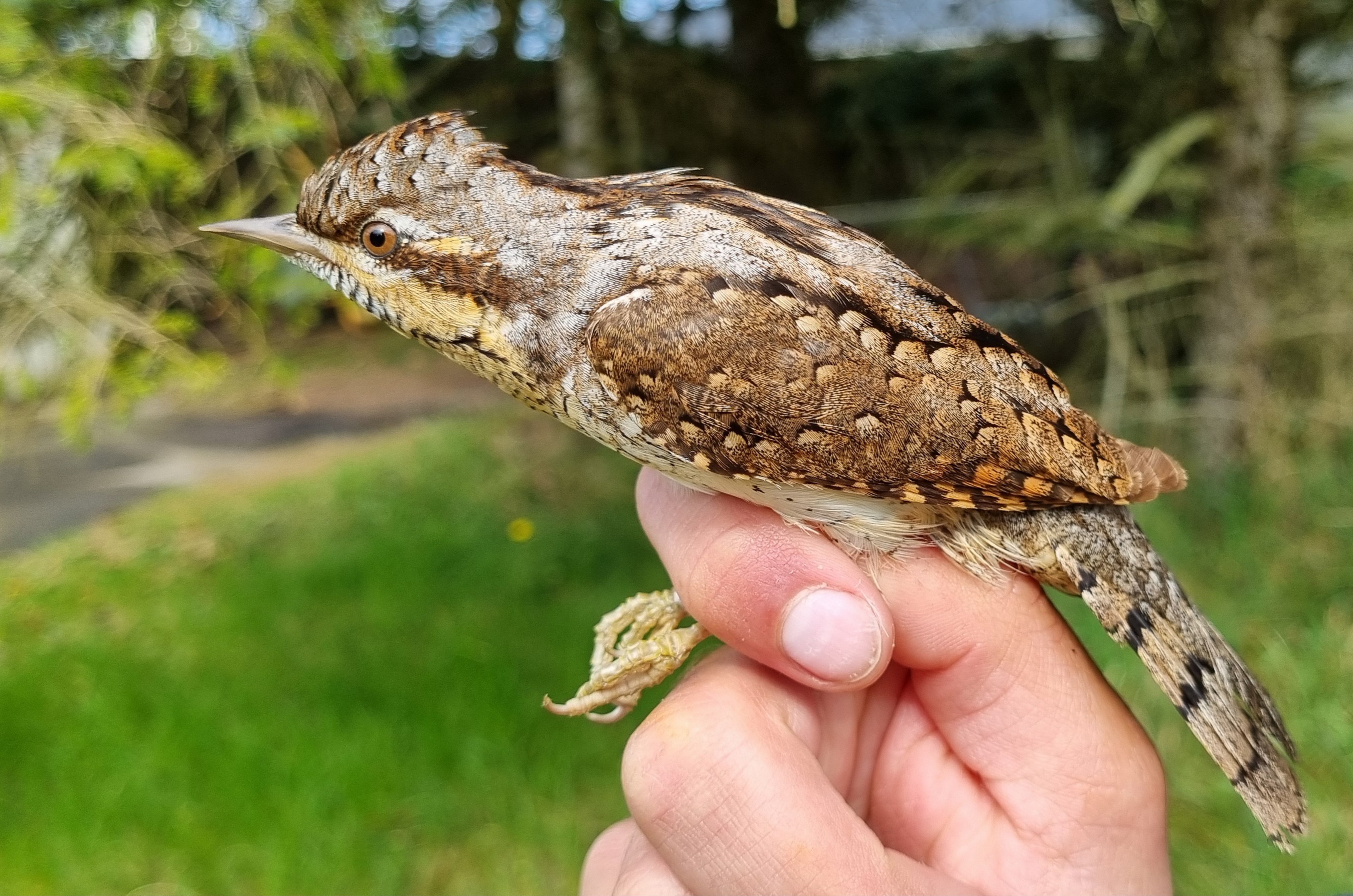
After ringing the wryneck, I went in to the dunes with a spotting scope. The beach was windy and there where probably windy, so we figured it might be fun to sit on a dune and scan for raptors. This resulted in one white-tailed eagle, a red kite, a marsh harrier, a buzzard, 3 raven and 2 kestrels. After one hour, I decided to go to the beach anyways, to look for ringed birds or other exciting sightings. One of the first things I saw was a metal ringed herring gull. He was a little shy, so it took half an hour to read the ring, but I managed to do so with the spotting scope, just in time, 5 minutes later it flew away never to be seen again. It was probably a Danish bird. When I was reading the ring, Morten mentioned he had seen a montagus harrier. Shoot, I missed it, too bad…
As I walked further I heard gulls alarming. I looked up and saw a few gulls bullying another gull. But wait, that is not a gull, it is an osprey! Click click click and gone it was.
I went further on the beach and I read 3 more colour ringed little terns, but that wasn’t easy, because the wind was getting stronger every minute. I decided to call it a day and went back to the station. I tried to read some rings of the tree sparrows, but it unfortunately didn’t work out, I just saw half the ring when it flew away.
Michael ankommet
Der var frisk vind på 8-9m/s fra sydsydvest da vi stod op og Maxim og jeg måtte arbejde med lidt færre net åbne i haverne pga vinden.
Det gav nu alligevel en del ringmærkede fugle og godt var det, at der nu er kommet gang i ankomsterne af de i Afrika overvintrende arter, så der både kom Rødstjert og Broget Fluesnapper med på dagens ringmærkningsliste.
Det gav mig mulighed for at få flere blodprøver udtaget og sendt til Statens Serum Institut.
I løbet af morgenen og formiddagen kom der besøg af Wilbert fra Holland, der er på en uges ferie med familien på Rømø.
Han havde tidligere kontaktet os for muligheden for at komme med på nogle netrunder og se hvordan vi arbejder og sammenligne med de Hollandske fuglestationers ringmærkning.
Kl 9 ankom Michael fra Holland for 2 månders ophold her, så havde det ikke været for, at David var her og tog morgenobsen, mens Bent og Svend Aage kom ud for lidt obs og arbejde med digitalisering af gamle årgange af fuglestationens dagbøger, så havde hovedsproget på fuglestationen i dag været Hollandsk!
Ude på obsposten fik David fine antal af Suler og terner i morgentimerne, med 144 Suler og 610 Hav/Fjordterner. Derudover blev det bl.a. en enkelt Havlit, 2 Almindelig Kjover, en Dværgmåge, en Havørn og et par Landsvaler.
Bent og Svend Aage hev den første Bysvale i år hjem fra deres obs omkring fuglestationen og Rørhøg over Mosen, mens Michael kom på plads og startede med manér, da han på en tur rundt på stranden og Mosen midt på dagen, både fandt en Sanglærke rede og fik aflæst en af de farvemærkede Dværgterner.
Ternen var mærket i sommeren 2021 på Fanø. Er tidligere aflæst her i yngletiden i 2022, men ikke set i 2023. 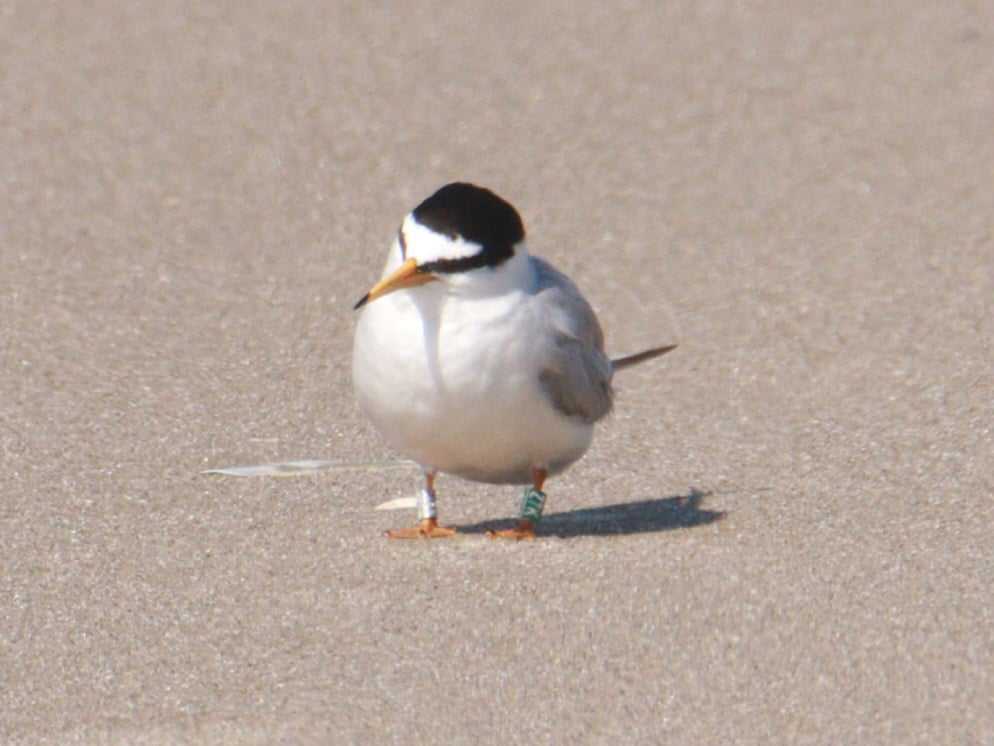
Michael lagde hårdt ud med aflæsning af en Dværgterne på stranden - lover godt for hans 2 måneders ophold her ikke mindst da han på en aftentur til stranden fik aflæst flere Dværgterne og havde en Storkjove, der efterhånden er blevet et ret sjældent syn ved Hukket.
En anden aflæsning kom via mail fra ringmærkningscentralen, da en hun Kvækerfinke, som vi ringmærkede den 22. april, i går blev genfanget i Hurup, Thy.
Den er altså kommet 126km mod nord i løbet af de 6 dage.
Dagens ringmærkning:
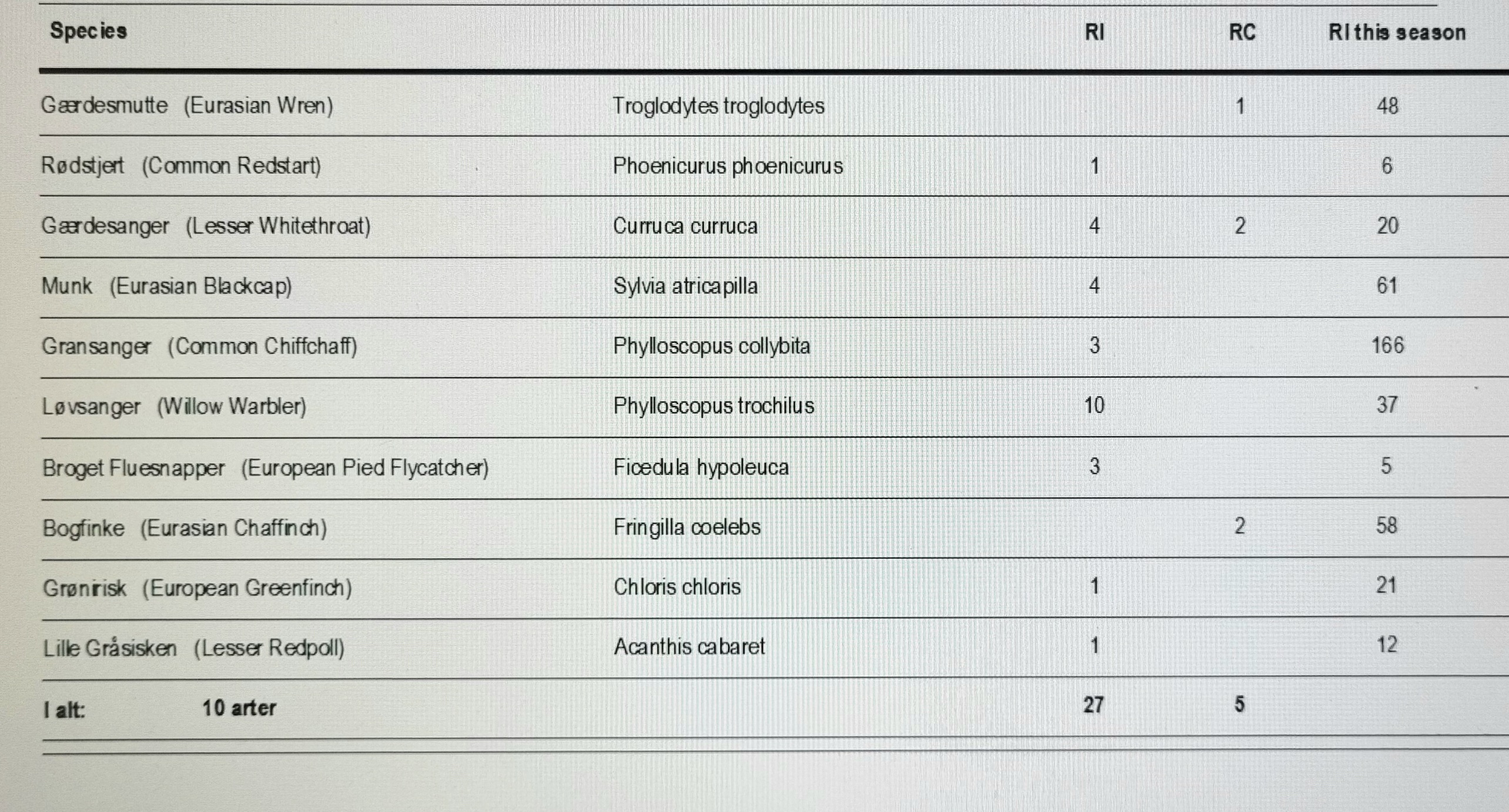
Folk på stationen: Bent, Svend Aage, David, Maxim, Michael og Morten
